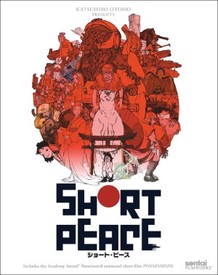Review
by Theron Martin,Short Peace
Blu-Ray
| Synopsis: |  |
||
Short Peace is an omnibus production collecting together one introductory piece and four short stories. In “Opening,” a girl playing hide-and-seek comes across assorted hyper-scientific wonders. In “Possessions,” a traveling repairman in 18th century Japan takes shelter in a dilapidated shrine during a storm, only to discover that the spirits of many worn-down objects inhabit it. In “Combustible,” an Edo-period young woman laments that she is being married off to someone other than the aspiring fire crew member that she has long loved; only a massive fire can bring them back together one last time. In “Gambo,” a massive, battle-scarred white bear helps a girl and a traveling samurai combat an ogrish brute who appears to have come from outer space and is using a village's women as brood mares. Finally, in “A Farewell to Weapons,” a highly-trained, well-equipped recovery team in a post-apocalyptic setting encounters a particularly troublesome automated tank, left over from the war, during one mission. |
|||
| Review: | |||
Short Peace is also the name of a collection of manga short stories by Akira creator/director Katsuhiro Ōtomo, which was published in the 1970s. Here, like with the collection Memories, his name is the binding element to another collection of shorts, in this case all animated by Sunrise; he is the director of one of the pieces (Combustible) and the original creator of another (A Farewell to Weapons). While A Farewell to Weapons was directed by longtime Gundam and Super Robot Wars OG mechanical designer Hajime Katoki, the other three were directed by men who were, at the time of the pieces' productions, known primarily for their work in shorts: “Opening” was directed by Kōji Morimoto, who is probably best-known for the Magnetic Rose segment of Memories; Gambo was directed by Hiroaki Ando, who is best-known for Five Numbers!, and Possessions was directed by Shuehi Morita, who at the time was best-known for Freedom!, Coicent, and Kakurenbo but has since gone on to direct Tokyo Ghoul. The introductory and four regular pieces total about 65 minutes in length, not counting the end credits. Since their artistic styles and story elements are each dramatically different, they will each be described separately below. Opening Possessions Combustible Gambo A Farewell to Weapons As one might expect, the musical score also varies dramatically in style from piece to piece. Each one is equally well-supported, though, and the differing sounds are each strongly-suited to its story. The theme song at the end of “A Farewell to Weapons,” “Yume de Amishou,” has a classic 1940s sound, a sharp contrast to the American rock-style “Motorcycle,” which is not exactly an opener but is used at the beginning of Farewell. Given their past track record in releasing one-shots, pairings, or collections of shorts, that Sentai Filmworks is responsible for this release is hardly surprising. (They seem to be the only American anime company willing to do this.) Their Blu-Ray release, which comes in a slipcover, includes one postcard-sized art card for each of the four main pieces but otherwise has no Extras beyond trailers. The visual production on the Blu-Ray is very good and the DTS-HD Master Multi audio is outstanding. The English dubs directed by Kyle Jones offer no complaints, as each is well-cast, well-performed, and does not vary markedly on script. For anyone interested in animation – and not just anime – Short Peace is well worth a look. It offers impressive creativity, variety and range; at least a couple of these pieces are likely to suit any tastes. NOTE: Grades below reflect overall averages (except for Music, which was consistently at that level) and should not be taken as specifically applying to any particular piece. |
| Grade: | |||
|
Overall (dub) : B+
Overall (sub) : B+
Story : B
Animation : B+
Art : B+
Music : A-
+ Fantastic artistry on some pieces, great creativity and variety, strong supporting music and dubs. |
|||
| discuss this in the forum (10 posts) | | |||
| Production Info: | ||
|
Full encyclopedia details about Release information about |
||